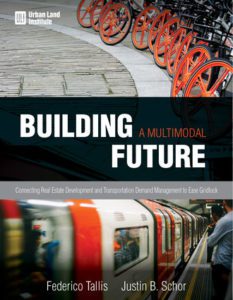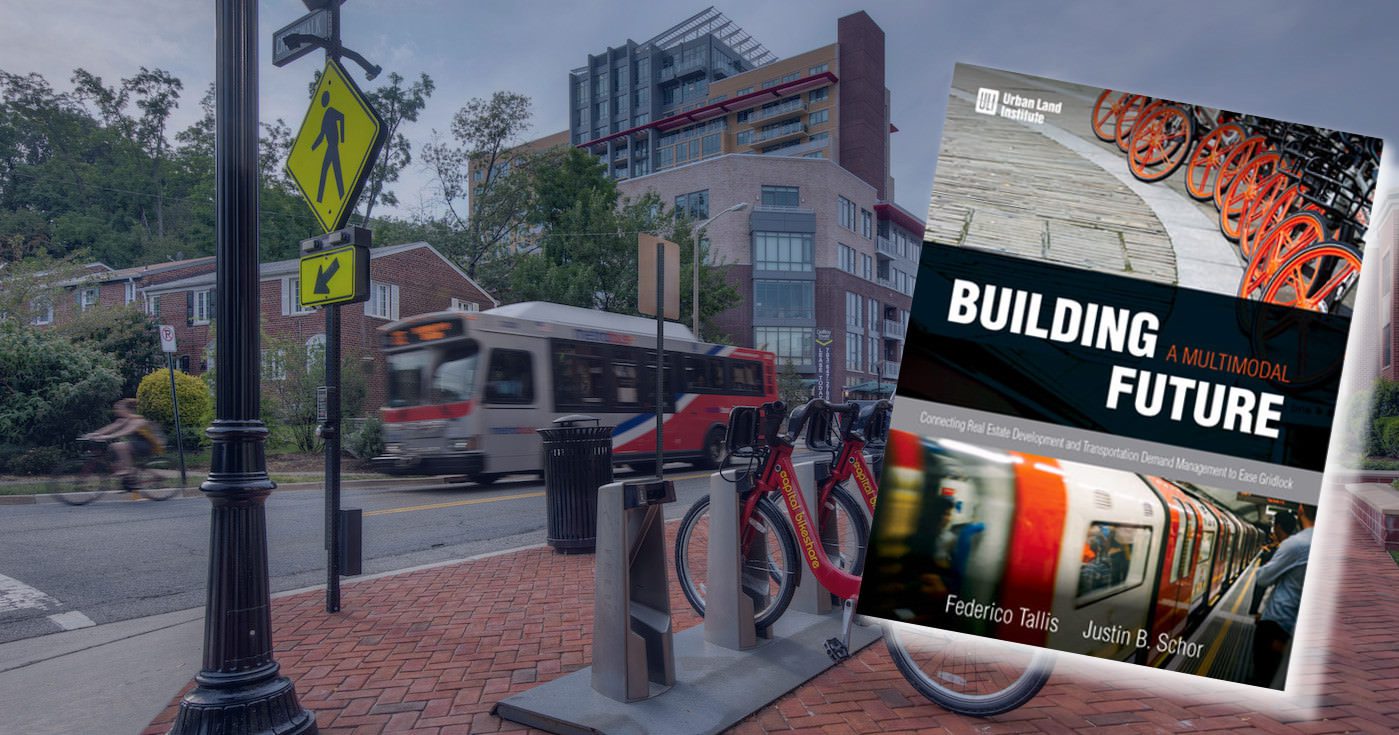Justin Schor, co-author of the Urban Land Institute’s new book, Building a Multimodal Future, recently had a “digital conversation” with colleagues at ULI who have been instrumental in the review, publication, and promotion of this newly published book. We hope that this discussion gives transportation and land use stakeholders and other interested readers some additional insight into why ULI decided to publish the book and disseminate these concepts to increase density and reduce parking with TDM.
 Joining us in this conversation were:
Joining us in this conversation were:
- James Mulligan, Senior Editor at the Urban Land Institute
- John Hempelmann, Member and Former Chair of ULI’s Transit Oriented Development Council and a founding partner and Chairman of Cairncross & Hempelmann, a land use, natural resources, and real estate development law firm, and
- Alex Schroeder, Manager of Product Marketing at ULI, with a background in marketing, program management, and writing for organizations including think tanks and nonprofits
Justin Schor:
Thank you all for participating in this conversation! I have been grateful for the opportunity to work with ULI on the publication of this book and, with this conversation, we hope to give readers a better understanding of why and how this book made it into print. I’ll dive right in with some questions …
Q: How did ULI’s publishing team determine that TDM was a topic worth publishing for your members and others?
Alex Schroeder:
 ULI membership is an interdisciplinary group of worldwide leaders in the real estate and land use fields. As such, there are several audiences we foresaw as possible targets for a book on TDM policies, especially since the book connects transportation with land planning in order to create safer, more walkable environments.
ULI membership is an interdisciplinary group of worldwide leaders in the real estate and land use fields. As such, there are several audiences we foresaw as possible targets for a book on TDM policies, especially since the book connects transportation with land planning in order to create safer, more walkable environments.
These audiences include members in the public sector, especially local government, who work directly on transportation planning, as well as developers, large and small-scale, who are looking for best practices and case studies on creating property-based transportation amenities for the new generation of tenants. Additionally, the book’s point about effective TDM policies contributing to easing gridlock, encouraging multimodal choices, and increasing density all while improving ROI on development, fits within ULI’s beliefs and mission of creating thriving communities worldwide.
Q: Jim, what is your role at ULI?
James Mulligan:
I am the senior editor, responsible for editing or managing the editing of all major ULI publications, including books, reports, white papers, newsletters, and marketing materials, as well as Urban Land magazine.
Q: My colleagues and I have always found ULI to be a great professional resource and community. What can you tell our readers who don’t yet know about ULI?
James Mulligan:
The Urban Land Institute (ULI) provides leadership in the responsible use of land and in creating and sustaining thriving communities worldwide.
Q: How extensive is ULI presence and network?
James Mulligan:
ULI has more than 42,000 members worldwide, representing the entire spectrum of the land use and development disciplines in private enterprise and public service—leading property owners, investors, developers, service firms, planners, public officials, and academics.
Q: John, why did ULI’s TOD Council agree to review Building a Multimodal Future?
John Hempelmann:
 We agreed to review the new book because we need the best possible research and analysis on how we can move people between houses, jobs, education, recreation, etc. The “T” in TOD is Transit but transit must be connected to buses, cars, bikes and good pedestrian facilities.
We agreed to review the new book because we need the best possible research and analysis on how we can move people between houses, jobs, education, recreation, etc. The “T” in TOD is Transit but transit must be connected to buses, cars, bikes and good pedestrian facilities.
Q: You mentioned Transit Oriented Development. Why did you decide to become a member of ULI’s TOD Council?
John Hempelmann:
I became a member of the TOD Council shortly after it was formed because we are spending close to $100 billion in the Seattle Metro area on new high-capacity transit systems and facilities. The region is growing rapidly and it is forecast that 75% of our new population and employment growth must occur within 1/2 mile of high-capacity transit nodes. The same is true of many other metro regions!
Q: What does the TOD Council hope that Building a Multimodal Future will do to advance its priorities and TOD in general?
John Hempelmann:
We need to advance all modes of transportation that are alternatives to SOVs. The book helps us achieve our objectives. All the sectors of our TOD Council—developers, investors, planners and other professionals, public and transit system officials—will learn from the new book.
Q: Which members of ULI’s TOD Council comprised the review committee for this book?
John Hempelmann:
In addition to me, the review committee included Anish Kumar – Acting Senior Director of Real Estate Development with Amtrak, Brian Leslie – Managing Director with Prescott Realty Group, and Robert Paley – Director, Transit‐Oriented Development with the New York Metropolitan Transportation Authority.
Q: Alex, what are some of the ways that ULI is publicizing this new book and the topic of TDM as a tool to increase density and reduce parking?
Alex Schroeder:
Our marketing plan includes top billed promotion on our main page (americas.uli.org), a press release from our communications team, a feature article in our Urban Land magazine online, targeted emails to members in America, features in relevant ULI newsletters (including the Urban Land weekly newsletter, the Building Healthy Places newsletter, and the News You Can Use newsletter to all of our District Councils), and targeted social media promotion from the ULI national account on all platforms through the end of our fiscal year (June 30, 2019).
We are also working with District Councils on hosting one or both of the authors to schedule programming around this book, with one or both of the authors presenting. We also are planning to do a webinar open to all Americas members that will further discuss the key findings from the book.
Justin Schor:
Thank you all for taking the time to discuss Building a Multimodal Future and ULI’s role in this initiative. We appreciate it!

